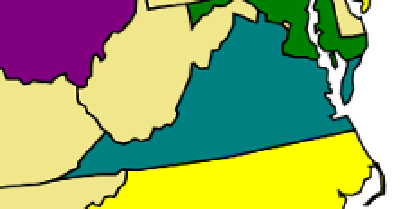HTML and CSS Reference
In-Depth Information
path
{
stroke: black;
/*
fill: khaki;
*/
}
4.
Press F5 to start the application and go to the map page. Virginia should no longer
use the default color as shown in Figure
9-17
.
Figure 9-17.
Virginia styled with JavaScript
5.
Now you'll also use JavaScript to implement the hover style. You can use the
event.target
property to get the
path
element that triggered the event. You can then
determine the state code by accessing its
id
attribute. Add the following methods to
the existing
script
element.
function hoverState(e) {
var event=e || window.event;
var state=event.target.getAttributeNS(null, "id");
var path=document.getElementById(state);
path.setAttributeNS(null, "fill-opacity", "0.5");
}
function unhoverState(e) {
var event=e || window.event;
var state=event.target.getAttributeNS(null, "id");
var path=document.getElementById(state);
path.setAttributeNS(null, "fill-opacity", "1.0");
}
6.
Then bind the
mouseover
and
mouseout
event handlers by adding the code shown
in bold to the
adjustStates()
function. This uses the
addEventListener()
method
to bind
hoverState()
and
unhoverState()
event handlers to each
path
element.
function adjustStates() {
var paths=document.getElementsByTagName("path");
for (var i=0; i<paths.length; i++) {
paths[i].setAttributeNS(null, "fill", "khaki");

